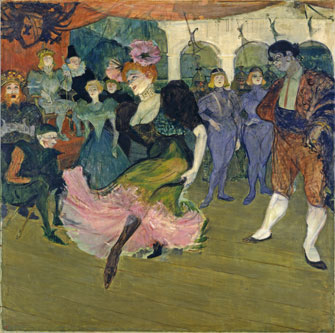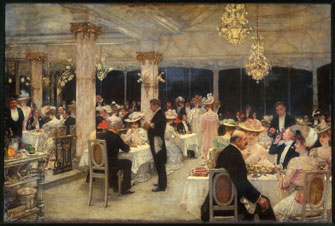The Invention of
Gay Paree

“Marcelle Lender Dansant le Boléro dans Chilpéric” (1895-96), by Henri de Toulouse-Lautrec. © Bridgeman Giraudon
If Paris were to be summed up in the popular imagination in one period of time, it might well be the Belle Époque, the subject of the wide-ranging exhibition “Paris 1900: La Ville Spectacle” at the Petit Palais. Think of Toulouse Lautrec’s dancing girls; elegant ladies with cinched waists, bustles and parasols; dandies in top hats and monocles.
In France, the memory of the humiliating defeat to the Prussians in 1870 and the violence engendered by the ensuing Commune was fading, and relative prosperity and political stability reigned during the Third Republic. The horrors of World War I were yet to come.
Paris, with its sparkling lights and flourishing nightlife, was the place to be. The boulevards cut through the city’s slums in the second half of the 19th century by Baron Haussmann were still bright, exciting places, lined with fashionable restaurants and theaters. Thrill seekers and sex tourists, notably the Prince of Wales (King Edward VII as of January 22, 1901) from across the Channel, flocked to Paris to visit the city’s opulent bordellos, while the working classes kicked up their heels at the new dance halls and cafés-concerts on the boulevards.
Art Nouveau was the style du jour, but other, still-unknown artists, Picasso (who had just arrived in Paris) among them, were working up to creating the revolutionary new art movements of the 20th century. Paris could boast a brand-new Métro system; two new train stations, the Gare d’Orsay and the Gare d’Invalides; and a new bridge, the Pont Alexandre III.
It was in this context that the 1900 Exposition Universelle, one of the most extravagant of the many held in the city, took place. Fittingly, the Petit Palais itself, like its big brother across the street, the Grand Palais, was built for the fair.
This show is nothing if not comprehensive, bringing the era to life with everything from paintings, sculpture, photos and film to fashion, furniture and ceramics. Some of the first film footage, by the Lumière Brothers, shows the top-hatted, be-bustled crowds at the fair, which attracted a record 51 million visitors, while Albert Guillaume’s colorful watercolors offer amusing portraits of ordinary people of the day: a soldier, a balloon seller, a news vendor, a café waiter, a gardener, a petit rat de l’opéra (a ballet chorus girl, here shown facing a fat man in tails and top hat, who is chucking her chin), etc.
Many of the great painters of the day are here: Toulouse-Lautrec, of course, but also Impressionists like Claude Monet and Alfred Sisley, society portraitists like Giovanni Boldini and Jacques-Emile Blanche, along with works by Cézanne, Courbet, Degas and many others.
From the more upscale side of the “Disneyland of sex,” as one of the curators describes Paris at the time, we have the special “love chair” built to order for the portly Prince of Wales and kept for him in his own room in a sumptuous Paris brothel at 12, rue Chabanais. It is always amusing to try to figure out just how he used this contraption, which rather resembles a luxurious gynecologist’s chair. In his private room, he also had a swan-shaped bathtub, which was filled with Champagne before use.
The stunning Art Nouveau ceramics, glassware and jewelry, by the likes of René Lalique and Gaston-Albert Chopard, are not to be missed.
Fashion is represented by everything from a lavish evening cape by Charles-Frederick

“Un Soir de Grand Prix au Pavillon d’Armenonville” (1905), by Henri Gervex. © Paris, Musée Carnavalet/Roger-Viollet
Worth, which belonged to the Comtesse Greffulhe (the model for Marcel Proust’s Comtesse de Guermantes) to a pair of scarily narrow brown leather ladies’ shoes.
Gay Paree was not all glitter, sex and style, however. Prostitution, drugs and absinthe took their toll. I learned a new word from the title of Théophile-Alexandre Steinlen’s dark engraving representing the Paris underworld: “Deux Gigolettes et Deux Gigolos” (1898-1902) showing two pimps and their “gigolettes.”
Better known throughout the world was the sophisticated Parisienne. This description by a journalist of the period might have been written today: “The Parisienne is distinguished from other women by an understated elegance appropriate to every circumstance in life. Her characteristics are restraint, good taste, innate refinement and that indefinable something which is unique to her, a mixture of allure and modernism that we call chic.”
And so a myth was born.
Petit Palais: Avenue Winston Churchill, 75008 Paris. Métro: Champs-Elysées Clémenceau. Tel: 01 53 43 40 00. Open Tuesday-Sunday, 10am-6pm (until 10pm on Thursday). Closed Monday and public holidays. Admission: €11. Through August 17, 2014. www.petitpalais.paris.fr
Reader reaction: Click here to respond to this article (your response may be published on this page and is subject to editing).
Please support Paris Update by ordering books from Paris Update’s Amazon store at no extra cost. Click on your preferred Amazon location: U.K., France, U.S.
More reviews of Paris art shows.
© 2014 Paris Update
Favorite